Milton Friedman's Theories on Corporate Social Responsibility
Info: 10605 words (42 pages) Dissertation
Published: 3rd Dec 2021
Table of Contents
1. Introduction
1.1. Business and society, profits and responsibilities
1.2. Aim of the study
2. Theoretical framework
2.1. Literature definitions of Corporate Social Responsibility (CSR)
2.2. Two main approaches to CSR
2.2.1. Shareholder approach (Friedman)
2.2.2. Stakeholder approach
3. Arguments in favor of CSR
3.1. A general overview of CSR benefits to firm
3.2. An economic static model to justify CSR
4. Managerial implications of CSV and real world implementation examples
4.1. Managers should reconceive products and markets
4.2. Managers should redefine productivity in the company Value Chain
4.3. Managers should Enable Local Cluster Development
5. Limitations and further researches
6. Conclusion
7. Appendix
1. Introduction
1.1. Business and society, profits and responsibilities
Milton Friedman’s controversial New York Times Magazine editorial, “The Social Responsibility of Business Is to Increase Its Profits” (1970), is an appropriate starting point for a discussion on the responsibilities of businesses towards society. Companies[1], if on one side, within the globalization and the economic development phenomenon, have increased their scale and scope and brought an unprecedented benefit for the public (creating jobs, wealth, and innovations…), on the other side may have also resulted in collective negative effects (so-called externalities[2]) such as environmental degradation, exploitation of labor, financial sector instability, to name a few.
A heated debate on self-regulation and Corporate Social Responsibility (CSR)[3] has thus sparkled between many economists and observers (Kitzmueller & Shimshack, 2012):
- What is the relationship between a business and the society within which it operates?
- What obligations does the business owe society while pursuing profits? (Werther & Chandler, 2010)
Friedman’s neo-classical dogma of amorality of business has contributed to build our time dominant perception of “sustainability” as a marginal and “anti-economic” activity. But, recent data on CSR spending (Fig.1) and surveys show “that enthusiasm for sustainability is growing across all industries”[4]. While in 2009 only 25% of managers said that they were increasing their commitment to sustainability, in 2011 the percentage went to almost 70%[5].
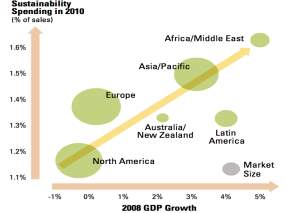
Fig.1. Source: Berns et al. (2011)
1.2. Aim of the study
In light of these recent trends, the aim of this report is to answer to the following questions:
- What does Milton Friedman mean when writing that the “one and only one social responsibility of business is to increase its profits“?
- Is Friedman’s vision fully incompatible with any form of CSR?
- Is there any economic justification[6] for businesses to engage in CSR activities?
- How can CSR perspective be implemented efficiently by managers and what consequences does it have on firms’ business models?
The following section introduces the theoretical framework of this study, by initially reviewing the literature definitions of CSR and afterward presenting the two main corporate governance approaches to CSR.
2. Theoretical framework
2.1. Literature definitions of Corporate Social Responsibility (CSR)
CSR is an elusive concept (Lee, 1987). Preston & Post (1975) characterized it as an “ill- and incompletely defined” notion; DeFillipi (1982) as lacking of theoretical integration and empirical verification; Jones (1983) as a speculative construction deficient of a dominant paradigm; Frankental (2001) as something that “can mean anything to anybody, and therefore is effectively without meaning.’’
CRS characterisation varies from the mere “philanthropy” interpretation (Lewitt, 1958), to the narrow economic perspective of increasing shareholder profits (Friedman, 1962, 1970); from the economic, legal, ethical and philanthropic strands of responsibility (Carroll’s pyramid model of CSR, 1991, Fig.2), to the good corporate citizenship (Hemphill, 2004) or the business integrated “shared-value” representation (Porter & Kramer, 2011).
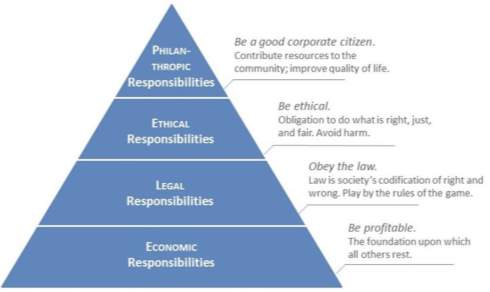
Fig.2. Source: Adapted from Carroll (1991)
To make some order, as a first step, it can be helpful to delineate the domain of application suggested by each of its constituent words:
- “Corporate”: it relates to corporations and organizations;
- “Social”: it defines society in its widest sense, embracing all its constituent groups;
- “Responsibility”: it is about obligations that are inherent on both sides of the relationship “corporation-society”.
Looking at the literature, a similar understanding of the concept can be traced back to 1953 Bowen’s publication “Social Responsibility of Businessmen”, where he answers the question “What responsibilities to society may businessmen reasonably be expected to assume?”:
“…businessmen [have] to pursue those policies, to make those decisions, or to follow those lines of action which are desirable in terms of the objectives and values of our society”[7].
More recently, Joyner & Payne (2002) have moved along the same direction, by considering CSR as referring to “categories or levels of economic, legal, ethical and discretionary activities of a business entity as adapted to the values and expectations of society” (p.300). Similarly, a notion related to “voluntary behaviour” is also implied by either the “beyond compliance” interpretation found in Baron (2001) and McWilliams and Siegel (2006)[8], or by the “self-regulation” paradigm as in Calveras et al. (2006) among others.
Despite the absence of a general consensus on the characterisation of CSR (Appendix A1), the definition provided by the Worldbank seems one of the most inclusive:
“commitment of businesses to behave ethically and to contribute to sustainable economic development by working with all relevant stakeholders to improve their lives in ways that are good for business, the sustainable development agenda, and society at large“[9].
It is important to notice that regardless of the definition used, it is always possible to outline two main literature perspectives to CSR: the shareholder and the stakeholder approaches.
2.2. Two main approaches to CSR
2.2.1. Shareholder approach (Friedman)
In 1970, on the New York Times Magazine, the Nobel prize–winning economist Milton Friedman resolutely stated that:
“There is one and only one social responsibility of business – to use its resources and engage in activities designed to increase its profits so long as it stays within the rules of the game, which is to say, engages in open and free competition without deception or fraud”.
Friedman’s article exposed to a larger audience his position[10], rooted in neoclassicism, on the moral foundation of business and social responsibilities. Soon it became the manifesto of the so-called shareholder approach to CSR.
For Friedman, businessmen who believe that a business needs to have a “social conscience” are just “unwitting puppets of the intellectual forces”[11], mining the foundation of a free society.
According to Hasnas (1998), Friedman position on business ethics can be justified by means of two distinctive arguments, the “utilitarian” and the “deontological” arguments.
The utilitarian argument focuses on the concept of self-interest. Friedman believes that market participants, by pursuing their own egoistic self-interests (seeking profits), are guided by an “invisible hand”, and unintentionally benefit society as a whole in a more efficient way (Pareto Optimality) than when they would by acting directly to promote the public welfare[12] (Shaw and Barry, 1998). Put differently, Friedman questions the competence of business leaders to discern and directly promote the general welfare and concludes that “the market itself is the best mechanism by which to promote the public good[13]”. Therefore, there is no justification to make a claim that “businesses have any social responsibilities other than to legally and honestly maximize the profits of the firm”[14].
The deontological argument, instead, gravitates around the observation that businesses are contractual arrangements between stockholders and executives (Hasnas, 1998). As such, managers’ “primary responsibility is to them”[15]: executives must not divert business resources away from the purposes expressly authorized by the stockholders, irrespective of any societal benefits that could be accrued by doing so[16]. They are always free, as private citizens, to spend their own personal funds for charitable or socially beneficial projects, but, when functioning as agents of the stockholders, if they engage in actions that are unrelated to profits maximization, they not only violate their fiduciary duties, but also become in effect “public employees” or “civil servants”, imposing taxes on business owners[17] and promoting an “unadulterated socialism”. In other words, in the shareholder perspective of Friedman, CSR can be just explained as a manifestation of moral hazard towards owners.
Hence, how to deal with businesses’ externalities? Friedman suggests that profits seeking firms, just as any private agent, do not have sufficient incentives to efficiently internalize the costs they cause and thus could not be expected to act socially or environmentally responsible. Consequently, although being a “market purist”, he advocates government intervention, through regulation or taxation, based on public preferences (not managers’) and democratic empowerment (not contractual).
It should be noticed that, Friedman did not suggest that business was free of ethics. For him business executives must observe the “rules of the game”: follow ethical customs, respect law, commit no fraud or deception, and involve in free and open competition (Harvey, 2000).
To sum-up, Friedman’s view analyses the corporate responsibilities at a micro-economic level. This approach appears too narrow in at least two ways. Firstly, even if shareholders only care about profits, stakeholders might not: by not considering their instances at all, firms’ earnings could be negatively affected. Secondly, also shareholders can have intrinsic, social or environmental, preferences going beyond pure profits[18], thereby finding it optimal to use the firm to maximize their own objective function at the expense of some monetary profits[19] . The broader stakeholder approach to CSR tackles these concerns.
2.2.2. Stakeholder approach to CSR
A broader perspective of corporate governance
Several authors have favored the so-called stakeholder approach when examining CSR.
This theory began to unfold during the mid-1980s, with the seminal work of Freeman (Freeman, 1984; Freeman and Reed, 1983) and within the widely belief that companies were prospering at the expense of a broader community.
Freeman’s (1984) contribution helped to re-conceptualize the nature of the firm, making gradually blurred its boundaries and encouraging the consideration of an extended network of other interests, for which, Longo et al. (2005), for example, provided a categorization (Fig.3).
| Stakeholder | Expectations/Interests |
| Employees | Health and safety work
Development of workers’ skills Quality of work Social equity |
| Suppliers | Partnership between ordering company and supplier
Selection and analysis systems of suppliers |
| Customers | Product quality
Safety of customer during use of product Consumer protection Transparency of consumer product information |
| Community | Environmental safety and production |
Fig.3. Source: Wiley, C., 2016
It is clear how, the term “stakeholders”, in its broadest meaning, goes well beyond the traditional interest groups of shareholders, customers, employees, and suppliers, and comprises also the whole social system in which a corporation is embedded, from the local communities to the environment – the also–called silent stakeholders (Simmons, 2004).
From this standpoint, CSR assumes two dimensions, internal and external (Karatas et al, 2014). Internal CSR addresses in-house priorities, dealing with issues related to employees’ skills and education, workplace safety and health, working conditions, equal opportunity, labour and human rights (Jamali et al., 2008). External CSR priority is instead put on the duties of corporations as citizens and on enabling a due diligence mechanism to their silent network of constituencies (Munilla & Miles, 2005; Jamali et al. 2008; Karatas et al., 2014) (Fig.4).
Fig.4. Source: Adapted from Jamali et al. (2008)
Stakeholder theory has therefore offered a new ground to organize thinking about organizational responsibilities, as well as for new forms of managerial actions to take place (Jonker & Foster, 2002). In contrast with the shareholder theory, the stakeholder approach did not exclusively focus on direct profit maximization, by suggesting that shareholders’ desires cannot be fulfilled without also addressing, to some extent, the demands of other stakeholders. In other words, “even when a firm seeks to serve its shareholders as a primary concern, its success in doing so is likely to be affected by other stakeholders”[20]. Moreover, scandals such as Enron collapse of 2002 or the financial sub-prime crisis of 2008 attracted the attention on the potential costs of irresponsibility (Petrick and Sherer, 2003), giving an impulse to new studies regarding the existence of potential links between CSR and corporate profitability. The consequence was the birth of notions like responsive and strategic CSR (Porter & Kramer, 2006).
From pure philanthropy, to responsive CSR, to strategic CSR
In the context of the stakeholder approach, it is possible to identify three types of CSR:
i. Pure Philanthropy (or general CSR)
When a company simply tackles generic social issues, not directly related to firm’s operations, its aim is just to redistribute profits to society. Similar CSR actions can be defined as philanthropy (Bosch-Badia et al., 2013) or as general CSR (Porter & Kramer, 2002).
As an example, for many years Ben & Jerry’s[21] through its foundation donated 7.5% of its annual pre-tax profits to charitable causes without expecting any specific benefit in return.
This kind of CSR projects are thus uncoordinated, unfocused and “neither strategic nor operational but cosmetic”[22], i.e. “primarily aimed at generating good-will and positive publicity and boosting employee morale”[23]. From the financial viewpoint, these are expenses, decreasing shareholders’ profits for the sake of a social or environmental end (they can be perceived as lacking of legitimacy). As such, Friedman’s critique fully applies to them.
Moreover, the absence of transparency together with the scarce corporate dedication in times of financial hardship, frequently associated with these CSR initiatives, have resulted in social responsibility programs of pure philanthropy often being abandoned by institutions (Brabeck-Letmathe, 2013).
ii. Value creation: responsive CSR
When companies considered CSR not only as an expense centre, but also as a potential value driver, linked to competitive advantage, it is possible to talk about value creation CSR (Porter & Kramer, 2002, 2006, 2011). This new orientation toward CSR can be summarized by the expression “Doing good to do well” (Vogel 2005, pp. 20–21), which refers to the possibility to reconcile business benefits and social responsibility, by identifying the points of intersection between the company’s activities value chain and the communities (Appendix A2). Logsdon et al. (1990) defined it as “the process by which contributions are targeted to serve direct business interests while also servicing beneficiary organizations”[24] .
In particular, Porter & Kramer encourage companies to adopt an operational approach to CSR, that evolves from a responsive approach to a strategic one.
The responsive CSR is defined as “good citizenship” or as a reaction to an external pressure, aimed at mitigating “harm from value chain activities”[25]. It can be induced by demand side pressures or as a “hedge against the risk of future government regulation or activism”[26], following a similar logic of financial “hedging”. Given this characterization, the most common perception of responsive CSRis the one of being a zero-sum game for the companies.
As an example, Nike in 1999, after being the target of several protests concerning its overseas shoes factories working conditions, imposed a code of conduct to its suppliers and conducted more than 600 factory audits in the next 5 years to assure that its standards were being met.
iii. Value creation: Strategic philanthropy, Strategic CSR and Creating Shared Value
In the context of the value creating CSR, academics have also defined a more specific set of CSR initiatives directly related to corporate strategy. Even for these strategy-related CSR actions, the interests of the company’s stakeholders and shareholders are aligned (Kurucz et al., 2008; Tencati and Zsolnai, 2009), so that the creation of value for society is simultaneously the creation of business value (Berger et al, 2007). But differently from the case of responsive CSR, here CSR agenda is company specific and internally generated, while projects are also a way to competing and not just the results of external demands or of management discretion.
In 2002, Porter & Kramer introduced a first idea of this kind, when, writing on corporate philanthropy, they advocated for strategic philanthropy, i.e. targeted charitable giving that contributes to both society improvement and corporate competitive context, and not just enabling cause-related marketing. So, for instance, Grand Circle Travels, US’s leaders in travel for seniors, since 1992, through their corporate foundation, have given more than $12 million to historical preservation projects in locations that its customers like to visit (Porter & Kramer, 2002).
In 2006, the authors extended this discussion from “strategic philanthropy” to strategic CSR. This new enlightened approach to management was looking not only at the strategic impact of donations, but at the whole perimeter of potential CSR activities, by proactively integrating the social dimension into the firm’s strategic planning and by linking competitive advantage and corporate social responsibility. Thus, strategic CSR means relating CSR projects to the company’s core business and choosing a unique position – i.e. “doing things differently from competitors in a way that lowers costs or better serves a particular set of customer needs”[27].
In particular, the more CSR initiatives are central with respect to the company value chain – becoming projects or ventures themselves and not only a side to activity –, the more they can provide business advantages (Burke and Lagsdon, 1996). Also, “the more closely tied a social issue is to the company’s business, the greater the opportunity to leverage the firm’s unique resources and capabilities and benefit society”[28]. An example of strategic CSR, it is offered by the car manufacturer Tesla, which has considered the reduction of environmental impact, not as an expense/obstacle, but as an opportunity to improve its competitiveness and build around its unique value proposition.
The aim of strategic CSR is “creating shared value” (CSV), which is “not social responsibility, philanthropy, or even sustainability, but a new way to achieve economic success. It is not on the margin of what companies do, but at the centre”[29]. Porter & Kramer (2011) explain that CSV has nothing to do with redistributing wealth. It is about increasing the size of the economic pie “for both shareholders and for the other stakeholders and society at large”[30].
As Fig.5 outlines, CSV, compared to philanthropy or general CSR, which focus on reputation or have only a limited connection to the business, focuses on the long run and it should be easier to justify to stakeholders.
| Traditional CSR | Strategic CSR |
| Value: Doing good to do well | Value: Economic and societal benefits to cost |
| Good citizenship, philanthropy, sustainability | Joint company and community value creation (Creating Shared Value, CSV) |
| External basis: discretionary or in response to peripheral pressure | Internal basis: integral to competing and value chain |
| Separate from profit maximization or at best zero-sum game | Integral to profit maximization |
| Agenda is determined by external reporting and personal preferences | Agenda is company specific and internally generated |
| Impact limited by corporate footprint and CSR budget | Realigns the entire company budget |
| Short term focus | Long run focus |
Fig.5. Source: Adapted from Porter and Kramer (2011).
Thus, value creation CSR initiatives, and in particular the notions of Strategic CSR and CSV, can help to reconcile the stakeholder view with Friedman’s. Although Friedman calls these practises “hypocritical window-dressing” when done under the “cloak of social responsibility”[31], he concedes that these may be justified if they contribute to shareholders’ interests.
Moreover, Porter and Kramer (2011) view that “It is not philanthropy but self-interested behaviour to create economic value by creating societal value” seems not that far from Friedman neoclassical interpretation of self-interest.
In conclusion, the managerial challenge with respect to strategic CSR is not just to create value through it, but also to make shareholders aware of this value creation.
3. Arguments in favor of CSR
3.1. A general overview of CSR benefits to firm
The conceptual enlargement brought by stakeholder’s theory has led the assumption that, if firms correctly allocate resources to CSR activities, then such activities can improve their brand image and reputation, attract qualified employees, enhance customer trust, boost competitive advantages and ultimately improve their financial performance (Fig.6). A MIT survey found that managers still consider the impact on company’s image as the dominant benefit of addressing sustainability. But associated economic benefits are on the rise (Fig.7).
| CSR Benefits | Elaboration |
| Financial Performance |
|
| Market Development |
|
| Innovation |
|
| Operational Efficiencies |
|
| Talent Management |
|
| Risk Management |
|
| Reputation Management |
|
| Stakeholder Relations |
|
Fig.6. Source: Adapted from Wiley, C., 2016
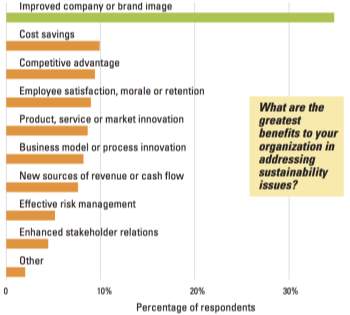
Fig.7. Source: Source: Berns et al. (2009)
3.2. An economic static[32] model to justify CSR
This paragraph is based on Lambertini & Tampieri (2010), Fanti & Buccella (2015). It provides an economic argument in favour of CSR, by showing that, in a large market, a profit seeking firm that follows CSR policies obtains higher returns compared to profit-seeking only firms.
The model
In an oligopoly market, there are
n>2 firms, selling a homogeneous product and competing with each other over output rather than price (price is given). The market demand function is
p=a-Q, with
a>0 and
Q=∑i=1nqi denoting the sum of all firms’ individual output levels
qi, while the production takes place at constant returns to scale with a marginal cost
i’s profits function is
πi=p-cqi.
For each unit of output produced, there will be also created a negative externality[33] (e.g. pollution)
E=gQ, where
g>0 is the marginal “externality effect” of the output (e.g. its marginal polluting intensity). The consumer surplus is measured by
CS=a-pQ2=Q2/2, while the social welfare is the sum of industry profits and consumer surplus, minus the externality:
W=∑i=1nπi+Q22-gQ
It is possible to study two different scenarios: in the first one, all the
nprofit-seeker firms competing a` la Cournot-Nash. In the second one, instead, there are
(n-1)profit-seekers Cournot firms, denoted as
i∈ 1,2,…, j-1,j+1,…n, and one
j∈ 1,…, nfirm socially responsible. In particular, it is supposed that firm
j internalizes its own share of externalities as costs and it is positively sensitive to overall society’ welfare.
Case 1: nprofit-seeking firms
The equilibrium quantity follows the traditional Cournot result:
qCN=a-c1+n=m1+n
where
m=a-c is defined as the market size.
The firms’ individual equilibrium profits are:
πCN=m1+n2
while, the consumer surplus and social welfare are:
CSCN=qCN22=12m1+n2 WCN=2n+12m1+n-gm1+n
Case 2: n-1 profit-seeking firms and one socially responsible firm
In this case, the socially responsible firm objective function is:
π̃j=πj-gqj+z(qi+Q-j)22
where
Q-j=∑i≠jqi and
z∈ [0,1] is the weight allocated by the firm
j to consumer surplus. The best reaction function of any of the
n-1Cournot firms is:
qi*=m-Q-i2
while firm
j explicitly integrates its concerns about social welfare and externality:
qj*=m-g-(1-z)Q-j2-z
Firm
j reaction function is flatter than those of the other Cournot firms, and is gradually flatter as
z↑:
∂qj*∂Q-j=1-z2-z
As the intercept of
qj* along the
qj axes is:
qj*|Q-j=0=m-g2-z>m2 , ∀ m> 2gz ,
the monopoly output of the socially responsible firm
j is larger than the pure profit-seeking monopoly output for all
m> 2gz (firm
j is more aggressive) (Fig.8).

Fig.8. Source: Lambertini & Tampieri (2010)
In other words, the intercept of firm
j’s reaction function shifts up or down depending on market size
m. If
m is large enough, as the function of firm
j is flatter and the intercept is higher than a standard Cournot firm, it will produce more than that.
The market equilibrium is given by the following firms’ optimal outputs:
qj=m-nm1-z+g1+n-z
qi=m1-z+g1+n-z
The firms’ profits are:
πj=m1-z+gmn-1z+1-gn1+n-z2
πi=(m1-z+g)2(1+n-z)2
Lastly, consumer surplus and social welfare are:
CSCSR=g-mn221+n-z2
WCSR=(g-mn)(m2z-2-n+2gn-z)2(1+n-z)2
Results
The necessary and sufficient condition ensuring that
πj>πi and
WCSR>WCN is:
m>maxg(1+n)nz,g(1+n)(1+2n-z)n2-z+2(1-z)
with:
maxg(1+n)nz,g(1+n)(1+2n-z)n2-z+2(1-z)=g(1+n)nz
for all
nz
maxg(1+n)nz,g(1+n)(1+2n-z)n2-z+2(1-z)=g(1+n)(1+2n-z)n2-z+2(1-z)
for all
nz>1 (Fig.9).
Proof provided in Appendix A3.
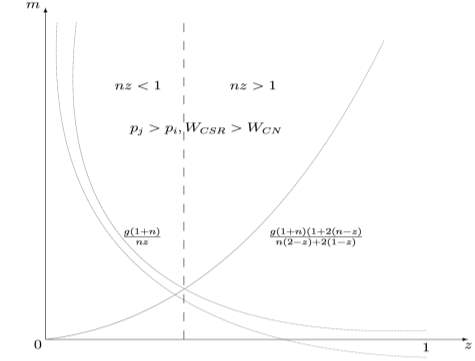
Fig.9. Source: Lambertini & Tampieri (2010)
Thus, in a large enough market (i.e. competitive), it is more profitable being a socially responsible firm rather than just a profit seeking firm. Also, the presence of the socially responsible firm improves social welfare as compared to a situation in which all firms are pure profit-seeking agents. This is because while the environmental concern restrains firm
j production, the social concern expands it and this “second effect more than offsets the first one”[34].
4. Managerial implications of CSV and real world implementation examples
Given the arguments exposed, it seems rationale for corporate executives to aim at CSV by designing and implementing projects according to their company’s strengths. In general, Porter & Kramer listed three main lines of interventions:
4.1. Managers should reconceive products and markets
By better serving existing advanced economy markets: companies need to re-think about how they fulfil traditional markets societal needs; new opportunities for differentiation and repositioning may exist. An example of this logic is Wholefoods[35],which does not just focus on traditional aspects of food product like quantity and taste. Indeed, the firm’s value proposition of natural, organic, and freshly prepared foods cater to better nutrition social needs or specialized nutritional requirements (gluten allergies, vegan, etc.), and also represents its differentiation strategy.
By accessing new markets, previously overlooked: company’s profits and societal benefits can be both substantially improved by addressing the needs of lower-income and disadvantaged consumers with appropriate products. For instance, Thomson Reuters[36] developed a $5 fee monthly service of weather, crop-pricing information and agricultural advices for Indian farmers that earn on average only $2,000 a year. This service improved significantly working condition, productivity and income (+60%) of 2 million farmers, and also created value for the company, that accessed an unserved market with an innovative product (Porter & Kramer, 2011).
4.2. Managers should redefine productivity in the company Value Chain
Managers should act simultaneously as stewards for natural resources (Bocken et al., 2013) and drive economic and social development (Fig.10). This can be done, for example:
by empowering supplier capabilities and efficiency: Nespresso[37]worked intensively with its coffee suppliers, by advising them on farming practices, by helping them to access to bank loans and to secure inputs such as plant stock, pesticides, and fertilizers. The results were a greater yield per hectare, a higher production quality, a more reliable and effective supply for Nespresso, and, in turn, an increased growers’ income, and a reduced environmental impact of farms (Porter & Kramer, 2011).
by improving energy, water and resource efficiency across the value chain: Coca‐Cola has reduced its worldwide water consumption (and input costs) by 2.5% in 2015 and by 27% since 2004, achieving a water-use ratio less than 2.0[38]. Stanley Black&Decker[39] by implementing lean manufacturing has directly led to waste and energy reduction and benefits for the local community (Taticchi et al., 2013)
by minimizing logistical intensity: Marks & Spencer[40] stopped “the purchase of supplies from one hemisphere to ship to another”; this simple action will not only reduce carbon emissions, but also “is expected to save the retailer £175M annually by fiscal 2016”[41].
by recruiting the diversity of customers/communities where a company operate: Project Shaktiby Unilever[42] provides microcredit and training for rural women and creates livelihood opportunities for them. The initiative counts over 72,000 micro-entrepreneurs covering 15 Indian states, accounts for more than 5% of Unilever’s total revenues in India, and contributes to build its brand in media‐dark regions.
by enhancing the productivity and wages of lower income employees: Cucinelli Spa [43] employees’ well-being is so central for the company that it pays them 20% more than the market average. This makes possible for the company to encourage and continue the Italian craftsman traditions, and also to ask clients to pay premium prices.
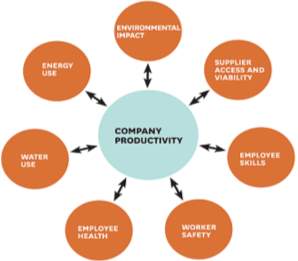
Fig.10. Source: Porter & Kramer (2011)
4.3 Managers should Enable Local Cluster Development
Companies success is affected by the supporting companies, the infrastructure, the public assets available in the community (schools, clean water, fair‐competition laws, …), the access to qualified and skilled labour. By improving the operating context, managers can benefit indirectly. As an example, Bureo Skateboards[44] developed a technology to palletize discarded fishing nets and to use those same pallets to produce skateboard decks. The company leveraged the community to create its supply chain from scratch, by entrusting the collection and handling of the fishing nets to fishing communities along the coast of Chile.
As in the case or Bureo Skateboards, new Sustainable business models (SBM)[45], incorporating a triple bottom line approach and considering a wide range of stakeholder interests – including environment and society-, emerge. Bocken et al. (2013) introduced a list of SBM Archetypes to “describe groupings of mechanisms and solutions that may contribute to building up the business model for sustainability”[46] (Fig.11).
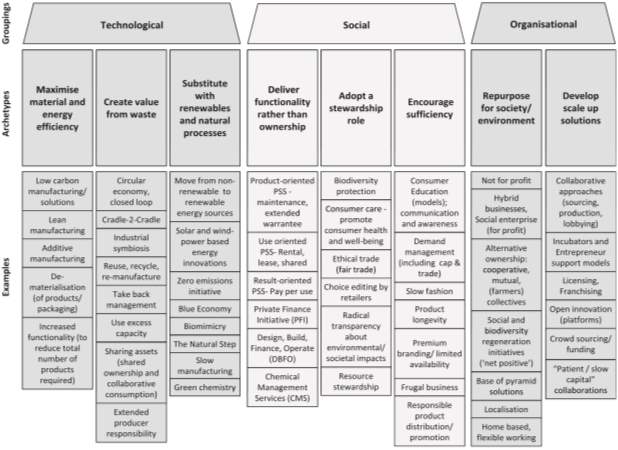
Fig.11. Source: Bocken et al. (2013)
5. Limitations of the study and directions for further research
This study essentially supports the managerial application of concepts like Strategic CSR, Creating Shared Value and Sustainable Business Models. Thus, its main limitations derive from the major critiques of these same ideas, which are summurized as follow:
- they assume compliance with government rules and regulations, while there is evidence that corporations are increasingly active in engaging with their regulatory environment (Crane et al. 2014);
- they fail to deal effectively with trade-offs between economic and social value creation, as they are predominantly seeking for win-win opportunities (Crane et al. 2014);
- they fail to deal effectively with the human dimension of making sustainability an integral part of the business – e.g. a board of directors may lack of familiarity with environmental issues (Visser, 2010);
- they don’t take into consideration the increasing short-term capital markets pressure for profits, which can be detrimental to firms committed to implementing strategic CSR[47] (Visser, 2010).
It is in particular for this latter point that more research and empirical evidence are required. Why do the financial markets still reward the externalisation of social, environmental and ethical costs over the short-run?
Why “sin mutual funds” like Vice Fund (VICEX), which holds a basket of stocks specializing in alcoholic beverages, tobacco, gaming and armaments industries”, consistently outperforms the market over the long term, including socially responsible funds? (Visser, 2010)
6. Conclusion
Friedman’s view on corporate social responsibility can be approached from three directions: one can agree with the author; disagree and critique his hypothesis; or, disagree but develop a hypothesis in line with current sustainability theory.
The current sustainability theory does not imply for companies to solely arrange “pure philanthropy” initiatives, or just to act in response to external stimuli, but suggests to them to rethink at the way they are making business. In particular, strategic CSR means adopting a sustainable approach along all the entire firm value chain to obtain a competitive advantage.
With respect to this extended and more refined form of CSR, Friedman’s view does not seem anymore incompatible. Indeed, a similar notion of CSR is aimed at both generate economic value for shareholders while also creating shared value (CSV) for society.
Firstly, firms can obtain different benefits adopting CSR practices, from reputational boosts to the attraction of talented employees or to the development of closer links with customers.
In terms of economic advantage, being socially responsible can positively impact on financial measures; in particular, in this research, it is shown that if the market is competitive enough, it is more profitable to embrace sustainability rather than being just a profit seeking firm.
At the same time, no governments, but businesses acting as businesses, and not as charitable givers, are possibly the most powerful force for tackling many of the pressing issues faced by our society, from environmental pollution to natural resources scarcity to exploitation of labor.
Lastly, new business opportunities are emerging also because of the growing social awareness of employees and citizens. For example, in UK, 70% of consumers stated that they are willing to pay more for a product perceived as ethically superior[48]. All these new opportunities require managers to design and adopt inherently sustainable business models making a positive contribution to society. A more sophisticated form of capitalism, one instilled with a social purpose, not out of charity but out of a deeper understanding of competition and economic value creation, can be on the horizon.
7. Appendix
A1: Other literature definition of CSR
(from Wiley, C., 2016)
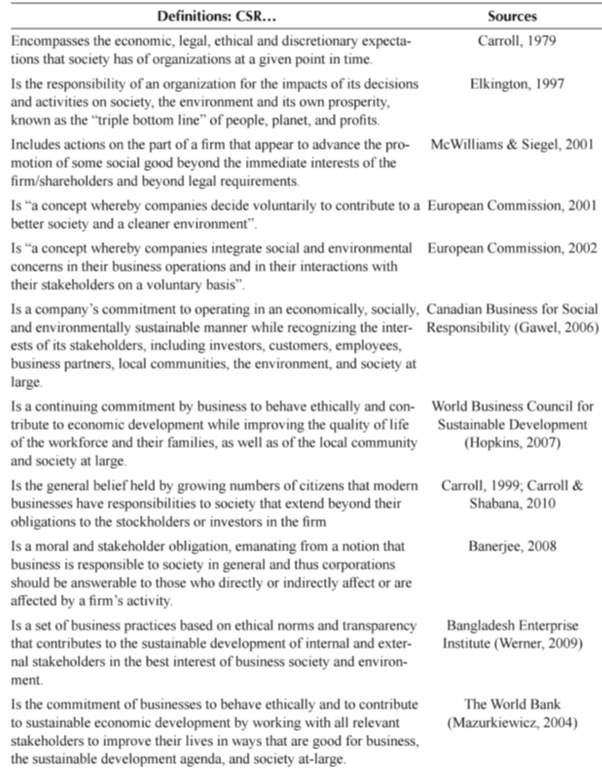
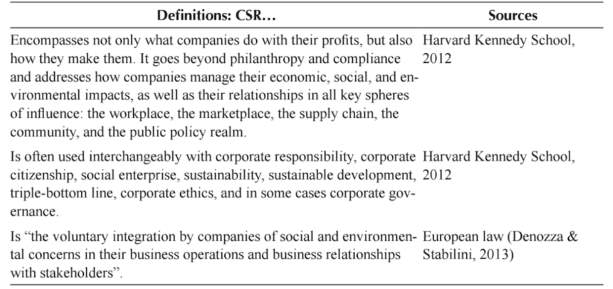

A2: CSR practices in leading companies
(from Wiley, C., 2016)
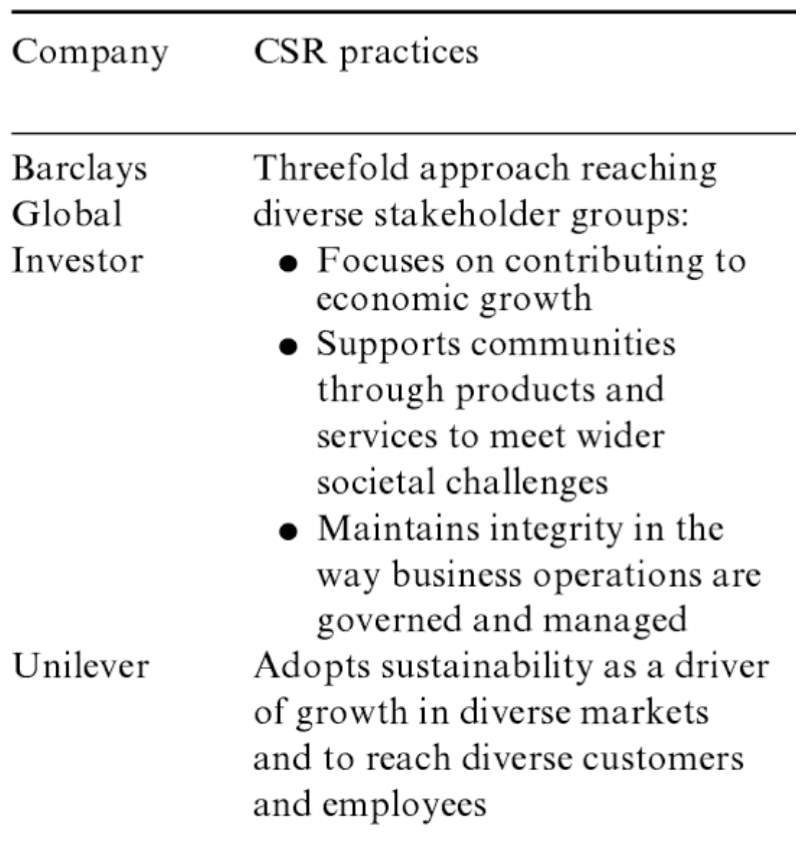
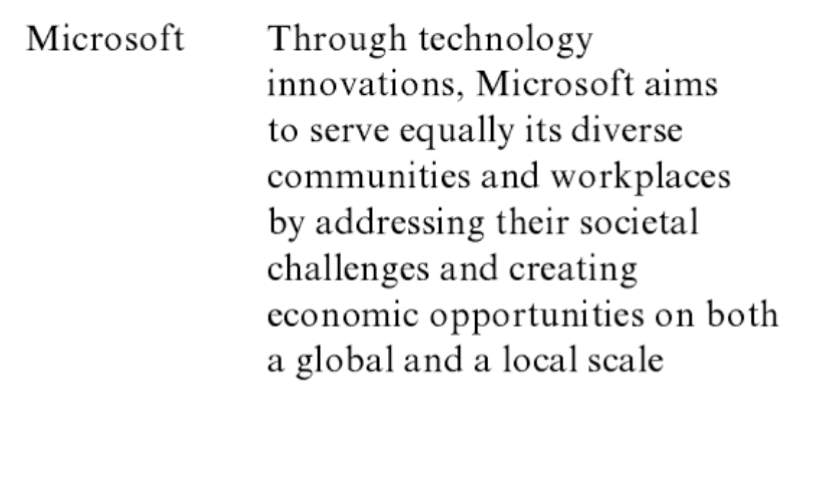
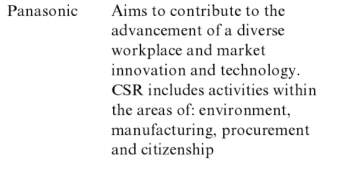



A3: Proof
(Lambertini, L., and Tampieri, A., 2010: p.10)
Profits are positive for all
m>g(1+n)/(nz), while
WCSR-WCN is a quadratic expression in
m.
WCSR=WCN in
m=g(1+n)/(nz) and
m=g(1+n)/(1+2n-z)/[n2-z+21-z], WCSR-WCN being positive for external values.
Case I: if
nz
g(1+n)nz>g(1+n)(1+2n-z)n2-z+2(1-z)
The profit difference is:
πj-πi=
=(m1-z+g)(mn-1z+1-gn)(1+n-z)2-m1-z+g21+n-z2=(g-mz-1)(mnz-g(1-n))(1+n-z)2
which is positive for all
m>gn/(1+n-1z), with
gn1+n-1z
always. Therefore, in this region:
m>g1+nnz
is necessary and sufficient to ensure both
πj>πiand
WCSR>WCN.
Case II: if
nz>1, then:
g(1+n)(1+2n-z)n2-z+2(1-z)>g(1+n)nz
Consequently, in this region,
πj>πi and
WCSR>WCN for all
m>g1+n1+2n-zn2-z+21-z.
References
Arndt, M. (2003). “An Ode to ‘The Money-Spinner,’” BusinessWeek, March 24, 2003, pp. 22–23.
Barney, J. B. (1991). “Firm resources and sustained competitive advantage”, Journal of Management 17(1), 99–120.
Baron, D. P. (2001). “Private Politics, Corporate Social Responsibility, and Integrated Strategy”, The Journal of Economics and Management Strategy, Vol.10, pp.7-45.
Becchetti, L., Giallonardo, L., and Tessitore, M.E. (2005). “Corporate Social Responsibility and Profit Maximizing Behaviour”, Working Paper No. 219, CEIS, University of Tor Vergata, Rome.
Berns, M., Townend, A., Khayat, Z., Balagopal, B., Reeves, M., Hopkins, M.S., and Kruschwitz, N. (2009). “Sustainability and Competitive Advantage”, MIT Sloan Management Review Special Report, Vol.51, No.1, (Fall, 2011).
Berns, M., Bussey, K., Murray, S., and Vismans, D. (2011). “Sustainability: The ‘embracers’ seize advantage”, MIT Sloan Management Review Research Report, in collaboration with The Boston Consulting Group. (Winter, 2011).
Bocken, N. M. P., Short, S. W., Rana, P., and Evans, S. (2014). “A Literature and Practice Review to Develop Sustainable Business Model Archetypes”, Journal of Cleaner Production, 65: 42-56.
Bosh-Badia, M. T., Montlor-Serrats, J., and Tarrazon, M.A. (2013). “Corporate Social Responsibility from Friedman to Porter and Kramer”, Theorical Economics Letters, 2013,3, 11-15.
Bowen, H. (1953). “Social Responsibilities of the Businessman”. New York: Harper.
Brekke, K. A., and Nyborg, K. (2005). “Moral hazard and moral motivation: Corporate social responsibility as labour market screening”, Memorandum 25/2004, Oslo University, Department of Economics.
Brabeck-Letmathe, P. (2013, June 19). FSG Impact – Executive Leadership’s Pivotal Role in Shared Value. (M. Porter, Interviewer)
Calveras, A., Ganuza, J.J., and Llobet, G. (2006). “Regulation, Corporate Social Responsiblity, and Activism”, Journal of Economics and Management Strategy, 16(3): 719-740.
Carroll, A. B. (1991). “The Pyramid of Corporate Social Responsibility: Toward the Moral Management of Organizational Stakeholders”, Business Horizons July–August, 39–48.
Carson, T. (1993), “Friedman’s Theory of Corporate Social Responsibility,” Business & Professional Ethics Journal 12 1993, no. 1.
Crane, A., Palazzo, G., Spence, L. J., & Matten, D. (2014). Contesting the value of the shared value concept. California Management Review, 56(2), 130–153.
DeFillipi, R. J. (1982). “Conceptual Framework and Strategies for Corporate Social Involvement Research”, in Research in Corporate Social Performance and Policy, JAI Press, Connecticut.
European Commission (2011). A new EU strategy 2011-14 for Corporate Social Responsibility. Brussels. COM(2011) 681 final, 25 October 2011.
Fanti, L. and Buccella, D. (2017). “Corporate social responsibility, profits and welfare with managerial firms”, Journal of Civil Economy, International Review of Economics, 1-16.
Frankental, P. (2001). “Corporate Social Responsibility- A PR Invention”, Corporate Communications: An International Journal 6(1), 18–23.
Freeman, R.E. (1984). “Strategic management: A stakeholder approach”, Boston: Pitman Press.
Friedman, M. (1970). “The Social Responsibility of Business Is to Increase Its Profits” The New York Times, September 13, 1970, pp.32-33 & 122&126.
Friedman, M. (1962). “Capitalism and Freedom”, University of Chicago Press.
Gaspar, A. (2003). “Possible Role of the Multilateral Investment Fund in the area of Corporate Social Responsibility”, Multilateral Investment Fund, Inter-American Development Bank, Washington, p. 3.
Harvey, J. (2000). “Smith, Friedman, and Self-Interest in Ethical Society”, Business Ethics Quarterly, Vol. 10, no. 3., 2000.
Hasnas, J. (1998). “The normative theories of business ethics: a guide for the perplexed”, Business Ethics Quarterly, Vol. 8 No. 1, pp. 19‐42.
Hemphill, T. (2004). “Corporate Citizenship: The Case for a New Corporate Governance Model”, Business and Society Review 109(3), 339–361.
Ipsos MORI, 2003. Ethical Companies.
www.ipsos-mori.com/researchpublications/researcharchive/849/ Ethical-Companies.aspx
Jamali, D. (2008). “A Stakeholder Approach to Corporate Social Responsibility: A Fresh Perspective into Theory and Practice”, Journal of Business Ethics (2008) 82: 213–231, Springer 2008.
Jamali, D., Safieddine, A., and Rabbath, M. (2008). “Corporate governance and corporate social responsibility: synergies and inter-relationships”, Corporate Governance: An Internation Review, 16 (5), 443-59.
Joyner, B. E., and Payne, D. (2002). “Evolution and implementation: A study of values, business ethics and corporate social responsibility”, Journal of Business Ethics 41 (4):297 – 311.
Jonker, J., and Foster, D. (2002). “Stakeholder excellence? Framing the evolution and complexity of a stakeholder perspective of the firm”, Corporate Social Responsibility and Environmental Management, 9, 187-95.
Jones, T.M. (1995). “Instrumental Stakeholder Theory: A Synthesis of Ethics and Economics”, The Academy of Management Review 20(2), 404-437.
Kitzmueller, M., and Shimshack, J. (2012). “Economic Perspectives on Corporate Social Responsibility,” Journal of Economic Literature. Vol. 50, No. 1, 2012, pp. 51-84.
Lambertini, L., and Tampieri, A. (2010). “Corporate Social Responsibility in a Mixed Oligopoly”, Working Papers, Dipartimento Scienze Economiche, Universita’ di Bologna.
Lee, L. (1987). “Social Responsibility and Economic Performance: An Empirical Examination of Corporate Profiles”, Un-published PhD Dissertation, US Inter- national University, San Diego.
Longo, M., Mura, M., and Bonoli, A. (2005). “Corporate Social Responsibility and Corporate Performance: The Case of Italian SMEs”, Corporate Governance 5, 28–42.
Levitt, T. (1958). “The dangers of social responsibility”, Harvard Business Review, September– October, pp. 41–50.
Manasakis, C., Mitrokostas, E., and Petrakis, E. (2007). “Corporate Social Responsibility in Oligopoly”, Working Paper No. 0707, University of Crete, Department of Economics.
Mazurkiewicz, P. (2004). “Corporate environmental responsibility: Is a common CSR framework possible?” WorldBank.
McWilliams, A., Siegel, D.S. (2002). “Corporate Social Responsibility: A Theory of the Firm Perspective”, Academy of Management Review, 2002, Vol.26 No.1, pp.117-127.
McWilliams, A., Siegel D.S., and Wright, P.M. (2006). “Corporate Social Responsibility: Strategic Implica- tions”, Journal of Management Studies.
Mitrokostas, E., and Petrakis, E. (2007). “Public Policy and Private CSR Activities: Complements or Substitutes?”, CSR Working Paper Series, Fondazione Eni Enrico Mattei.
Munilla, L.S., and Miles, M.P. (2005). “The corporate social responsibility continuum as a component of stakeholder theory”, Business and Society Review, 110, 371-87.
Osterwalder, A., Pigneur, Y. (2010). “Business Model Generation: A Handbook for Visionaries, Game Changers, and Challengers”. John Wiley & Sons, Hoboken, New Jersey.
Petrick, J. A., and Sherer, R. F. (2003). “The Enron Scandal and the Neglect of Management Integrity Capacity”, Mid-American Journal of Business 18(1), 37-49.
Porter, M.E., and Kramer, M.R. (2002). “The competitive advantage of philanthropy”, Harvard Business Review, December 2002, 57‐68.
Porter, M. E., and Kramer, M. R. (2006). “Strategy and Society: The Link Between Competitive Advantage and Corporate Social Responsibility”, Harvard Business Review 84(12), 78-92;
Porter, M. E., and Kramer, M. R. (2011). “The Big Idea: Creating Shared Value”, Harvard Business Review 89(1/2), 62-77.
Preston, L., and J. Post (1975). “Private Management and Public Policy”, Prentice Hall, New Jersey.
Reinhardt, F., Stavins, R., and Vietor, R. (2008). “Corporate social responsibility through an economic lens”, FEEM Working Paper no. 84.2008.
Simmons, J. (2004). “Managing in the Post-Managerialist Era: Towards Socially Responsible Corporate Governance”, Management Decision 32(3/4), 601–611.
Smith, A. (1776). “An Inquiry into the Nature and Causes of the Wealth of Nations [WN]”, in R.H. Campbell, A.S. Skinner, W.B. Todd, eds., Oxford, Clarendon Press, 1976.
Spiller, R. (2000). “Ethical Business and Investment: A Model for Business and Society”, Journal of Business Ethics 27, 149–160.
Taticchi, P., Short, S. W., and Tonelli F. (2013). “Sustainability as a driver of innovation in industrial business models: Learning from three Italian cases”, Conference: 20th International Annual EurOMA Conference 2013.
Visser, W. (2010). “The Age Of Responsibility - CSR 2.0 and the New DNA of Business”, Journal of Business Systems, Governance and Ethics, Vol. 5, No. 3, p. 7, 2010.
Vogel, D.J. (2005). “Is there a market for virtue? The business case for corporate social responsibility”, California Management Review 47, 19–45.
Werther, Jr. W.B., and Chandler, D. (2010). “Strategic Corporate Social Responsibility: Stakeholders in a Global Environment”, 2nd Ed. Los Angeles: SAGE Publications, Inc.
Wiley, C. (2016). “The whats, whys, and hows of corporate social responsibility”. In: Stachowicz-Stanusch, A. ed. Corporate Social Performance: Reflecting on the Past and Investing in the Future. Poland: Information Age Publishing, pp. 77-101.
Wood, D.J. (1991). “Corporate social performance revisited”, Academy of Management Review, October, 691–718.
[1] The term “company” comes from a combination of the Latin words cum and panis, whose literal translation of originally meant “breaking bread together” (Arndt, 2003), suggesting a kind of synergistic role with society.
[2] Externalities can be “good” or “bad” and are one reason why market fails to achieve the Pareto Optimal ideal.
[3] Different authors use different labels to indicate the same concept: corporate social responsibility (CSR), sustainability, corporate citizenship, business ethics, corporate conscience, social entrepreneurship, corporate accountability. In this report, all these different terms are interchangeable.
[4]Berns et al. (2011): p.7.
[5] Ibid.
[6] This is what Kitzmueller & Shimshack (2012) called a “business case” for CSR.
[7]Bowen, 1953: p.6.
[8] CSR includes all “situations where the firm goes beyond compliance and engages in actions that appear to further some social good, beyond the interests of the firm and that which is required by law” (McWilliams & Siegel, 2006: p.4).
[9] Definition developed in 1998 for the first WBCSD CSR dialogue in The Netherlands. For more see www.wbcsd.org.
[10] Already expressed in his 1962 book “Capitalism and Freedom”.
[11] Friedman, 1970.
[12] Friedman view on self-interest is consistent with Adam Smith’s: “It is not from the benevolence of the butcher, the brewer, or the baker, that we expect our dinner, but from their regard to their own interest. We address ourselves, not to their humanity but to their own interest” (Smith, 1776: 14).
[13]Carson, 1993: p.15.
[14]Hasnas, 1998: p.2.
[15] Friedman, 1970.
[16] Friedman is here reinforcing the free-market view that ‘desires’ are not the appropriate subject of moral scrutiny.
[17] Friedman (1970).
[18] Thus, departing from the classical homo oeconomicus assumption.
[19] Reinhardt et al. (2008: p.4) define CSR in this spirit as “sacrificing profits in the social interest”.
[20] Jamali, 2008: p. 217.
[21] US company, founded in 1978, manufacturing ice cream, frozen yogurt, and sorbet and considered as a pioneer of modern corporate social responsibility; http://www.benjerry.com/about-us.
[22] Porter & Kramer, 2002: p.3.
[23] Ibid.
[24]Logsdon et al., 1990: p.95.
[25] Porter & Kramer, 2006: p.11.
[26]Kitzmueller, 2012, p.21.
[27] Porter & Kramer, 2006: p.11.
[28] Ibid.
[29] Porter & Kramer, 2011, p.65.
[30] European Commission, 2011: p.6. “maximizing the creation of shared value for their owners/shareholders and for the other stakeholders and society at large” (European Commission, 2011, p.6).
[31] Friedman, 1970.
[32] Balboni (2009) proposed a dynamic model, based on the level of utilization of certain factors of production.
[33] In a Pareto Optimal world, firms produce till the marginal social benefit equals the marginal social cost. But in the presence of market failures, positive externalities are under produced and negative externalities over produced.
[34] Lambertini & Tampieri, 2010: p.4.
[35] American food retailer, founded in 1980, exclusively featuring “foods that are free of artificial preservatives, colors, flavors, sweeteners, and hydrogenated fats” (http://www.wholefoodsmarket.com/company-info).
[36] Multinational IT and Information industry firm delivering “critical information to leading decision makers in the financial and risk, legal, tax and accounting, intellectual property and science and media markets” (https://www.thomsonreuters.com/en/about-us.html).
[37] “Autonomous globally managed business of the Nestlé Group”, pioneer and market reference in premium portioned coffee industry (http://www.nestle-nespresso.com/about-us).
[39] Global provider of hand tools, power tools and related accessories, mechanical access solutions, electronic security solutions, healthcare solutions and more (http://www.stanleyblackanddecker.com/who-we-are/about-us).
[40] British multinational retailer founded in 1884 and specialises in the selling of clothing, home products and luxury food products (http://corporate.marksandspencer.com/aboutus).
[41] Porter & Kramer, 2011, p: 69.
[42] Dutch-British multinational consumer goods firm focusing on food, beverages, cleaning agents and personal care products (https://www.unilever.com/about/).
[43] Italian fashion house operating in the luxury goods sector. The firm is specialised in cashmere (€ 330M revenue in 2012) (http://investor.brunellocucinelli.com/en/business-model).
[45] “A business model describes the rationale of how an organization creates, delivers, and captures value” (Osterwalder & Pigneur, 2010: p.14).
[46] Bocken et al., 2013: p. 4.
[47] In 2010, 34% of 766 managers questioned by UN Global Compact and Accenture cited lack of recognition from the financial markets as a barrier to achieving their sustainability goals (Visser, 2010).
[48] IPSOS MORI (2003).
Cite This Work
To export a reference to this article please select a referencing stye below:
Related Services
View allRelated Content
All TagsContent relating to: "CSR"
Corporate Social Responsibility (CSR) is a concept of self-regulation where businesses make positive contributions to society or communities. CSR can include donations, voluntary work, environmentally friendly commitments, and more.
Related Articles
DMCA / Removal Request
If you are the original writer of this dissertation and no longer wish to have your work published on the UKDiss.com website then please:




